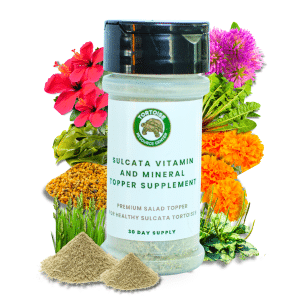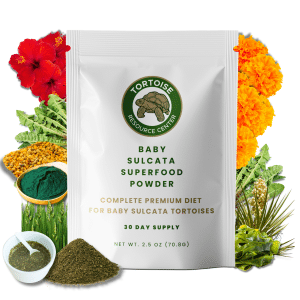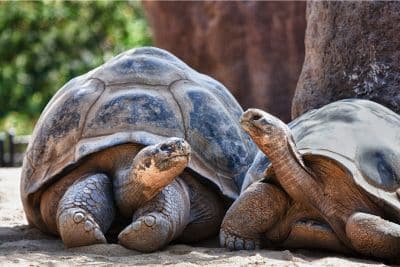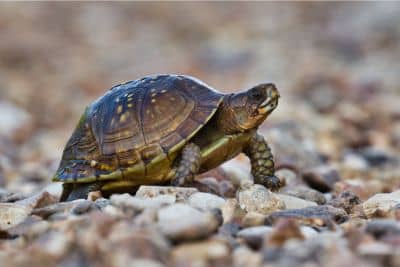The golden Greek tortoise is a unique variety of Testudo graeca, most easily recognized by its yellow skin and shell. These tortoises have been popular in the pet trade since the early 2000s, and are one of the most common subgroups of the species.
Greek tortoises are relatively easy to care for with agreeable personalities, making them great companions for new and experienced owners alike. The golden Greek tortoise is an exciting alternative that requires very similar care despite its striking appearance.
This article will introduce you to the golden Greek tortoise and everything you need to know about owning one yourself.
Introduction to the Golden Greek Tortoise
The name golden Greek tortoise is given to a couple of different subspecies within the pet trade. You probably won’t find any scientific references to golden tortoises.
The first known golden Greek tortoises belonged to the subspecies T. graeca terrestris. These tortoises come from Syria and boast the brightest coloring.
Other specimens come from the subspecies T. graeca floweri, or the Jordanian Greek tortoise. These tortoises are far less common than the Syrian group in the modern pet trade.
Both of these subspecies are smaller on average than the more common Greek tortoises. The typical golden Greek tortoise only measures 6 to 8 inches long, with females being larger than the males.
Golden Greek Tortoise Enclosures
Golden Greek tortoises can live indoors or outdoors given the right environment. Note, however, that your local climate will determine whether it’s safe to house your tortoise outdoors during much of the year.
Wherever your tortoise will spend its time, it needs space to do so. As a rule, any enclosure should be at least 10-times bigger than the tortoise it will contain. The minimum enclosure size for one of these tortoises is about 6 feet by 3 feet. I always recommend going larger.

Environmental Conditions
The best golden Greek tortoise enclosure will always be one that closely replicates the tortoise’s natural habitat. Key factors every owner must consider include temperature, humidity, and lighting.
Temperature
It’s believed that golden varieties come from the warmer parts of the Greek tortoise’s native range, and the subspecies’ temperature requirements reflect this. You’ll want to keep the enclosure’s temperature range at or slightly above that recommended for a common Greek tortoise.
Your tortoise’s heat lamp should be focused on one side of the enclosure. This will ensure that your tortoise can easily move around the enclosure to adjust its body temperature as needed. I recommend creating three distinct temperature zones within the enclosure:
- A basking spot around 95°F
- A warm zone around 85 to 89°F
- A cool zone around 72 to 77°F
While nighttime temperatures may be slightly cooler, the enclosure for your golden Greek tortoise should never drop below 70°F.
Humidity
While all Mediterranean tortoises require low humidity, this is particularly true of the golden Greek variety. Aim for an average humidity level of 35 to 45%. The humidity in a golden Greek enclosure should ideally never exceed 50%.
If your tortoise has a relatively small enclosure, I also recommend removing any permanent water sources. Dishes and other water sources can raise the humidity of a small, enclosed space a surprising amount. Note that you’ll need to provide an alternative water source (e.g., routine soaking) to prevent dehydration.
Excess humidity can contribute to common health issues like shell rot and respiratory infections in Greek tortoises. Use a hygrometer to monitor the humidity in your tortoise enclosure and don’t hesitate to make changes to the space if you notice the humidity levels trending upward.
Lighting
A heat lamp is not enough for a golden Greek tortoise (or any tortoise). While tortoises living outdoors get everything they need from the sun, indoor tortoises require a lighting set-up that provides daily supplemental lighting.
Tortoises need two types of UV light to survive: UVA and UVB. UVA light mimics the sun and helps your tortoise follow a normal day-night cycle. UVB light is essential for Vitamin D synthesis. Many reptile heat lamps also provide UVA and/or UVB lighting. You can also set up each light source separately.
For indoor tortoises, I recommend scheduled lighting. This is easy to achieve with an outlet timer or similar setup. A good starter schedule is to provide all supplemental lighting for 14 hours per day during the summer and 10 hours per day during the winter.
Are You Starving Your Tortoise?
Save 10% on premium tortoise food and supplements from Tortoise Resource Center on Amazon now using code BUYNOWGET10

Sulcata Vitamin & Mineral Topper Supplement
30-Day Supply | 2 oz (56 g)
$24.99

Baby Sulcata Tortoise Superfood Powder
30-Day Supply | 2.5 oz (70.8 g) Bag
$24.99
Substrate and Enrichment
The most popular substrates for Greek tortoises include coconut coir or a mixture of organic topsoil and play sand. My preference is for coconut coir, as it is non-abrasive and has some moisture retention properties that can assist with maintaining proper humidity levels.
If space allows, I highly recommend incorporating multiple substrate types within the enclosure. You can do this by ‘zoning’ the enclosure—I like to set aside a corner for behaviors like digging that contains more soil—or layering different substrates on top of each other.
Your choice of substrate is just one form of enrichment. Natural materials like rocks, wood logs, and potted plants can all provide simulated shelter and a more varied living space for your golden Greek tortoise.
Diet and Nutrition
I’ve found no difference in the nutritional needs of Golden Greek tortoises versus other members of the species. All Greek tortoises are exclusive herbivores who depend on fiber-rich grasses and leafy greens for the bulk of their diets.
My preferred feeding method is to offer a pile of vegetation about the size of my tortoise’s shell. After about 30 minutes, I remove any uneaten vegetation so that the remaining food doesn’t go bad or attract pests.
Supplements and Vitamins
Nearly all Greek tortoises benefit from a regular calcium supplement given with daily meals. Calcium is a vital part of healthy bone and shell development and is the most common deficiency seen in captive tortoises.
Breeding
Golden Greek tortoises can be cross-bred regardless of their subspecies. However, many breeders keep their Syrian and Jordanian tortoises separate in an effort to preserve the unique genetic traits of each group.
Breeding Considerations
Captive tortoise breeding typically doesn’t happen by accident. First, Greek tortoises prefer solitary life. This means that grouping males and females together should be a conscious decision at the time of breeding.
Second, breeding behaviors are triggered by seasonal changes. For indoor tortoises, you’ll need to replicate the shortened days and cooler temperatures of a false winter. Once the days re-lengthen and temperatures come back up, your tortoises will be apt to mate.
After successful breeding, it will still take several months for the eggs to incubate and hatch, I recommend incubating at 86°F. You can control the sex of the future hatchlings by either slightly lowering (for male hatchlings) or raising (for female hatchlings) the incubation temperature.
Citations
Reptiles Magazine Golden Greek Tortoises
Arizona Exotic Animal Hospital Basic Care: Golden Greek Tortoise


